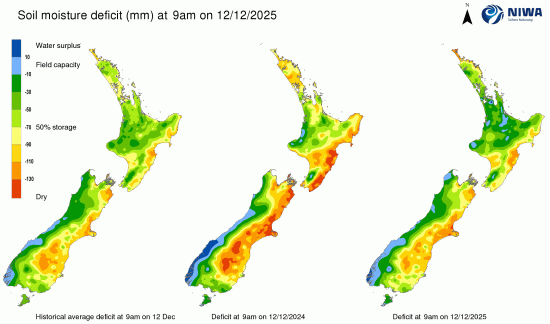
Here are the key things you need to know before you leave work today (or if you already work from home, before you shutdown your laptop).
MORTGAGE RATE CHANGES
No changes to report here today.
TERM DEPOSIT RATE CHANGES
TSB raised rates today. Heartland Bank also rated its TD rates.
FOREIGNER INFLUENCE STILL VANISHED
The September update to the property transfer statistics showed that just 0.5% of home transfers were to people without New Zealand citizenship or resident visas in the September 2022 quarter, compared with 0.4% in the September 2021 quarter.
A NORMAL LA NINA SUMMER
NIWA says this summer will be pretty normal, with a La Niña influence. They says we should expect above average temperatures nationwide, with periodic humidity expected from November. Sea surface temperatures may increase notably in November, and rainfall will be regionally variable, but at generally normal levels.
STILL VERY NEGATIVE, & UNUSUAL
Consumer confidence was unchanged in October at 85.4 which is a very low level. The proportion of people who believe it is a good time to buy a major household item, the best indicator for retail spending, rose 3 points to 22%. Inflation expectations were little changed at 5.0%, versus 5.1% last month. For consumers to be this worried looking at what they think is 5% inflation, and when the jobless rates remains very low, is quite unusual. Also unusual, businesses’ inflation expectations are now higher than consumer inflation expectations.
RISING FASTER IN OZ
Australian producer prices rose +1.9% in the September quarter from the June quarter, accelerating from a 1.4% rise in that prior period. Year on year they are up +6.4% which is also a faster rise in pace.
SWAP RATES REVERSE HARDER
Wholesale swap rates may be falling quite sharply again today and across the board, following global moves. The key real action comes near the close however. Our chart will record the final positions. The 90 day bank bill rate is down -3 bps at 4.06%. The Australian 10 year bond yield is now at 3.77% and down -9 bps extending their retreat. The China 10 year bond rate is down -2 bps at 2.71%. The NZ Government 10 year bond rate is now at 4.27%, and down another -16 bps but still well above above the earlier RBNZ fix for this bond at 4.22% which was down -14 bps from this time yesterday. The UST 10 year is now at 3.92% and down another -9 bps from this time yesterday.
EQUITIES MIXED
Wall Street ended their Thursday session with the S&P500 retreating -0.6% and leaving it up only +1.4% higher for the week. Tokyo has started today down -0.4% and heading for a flat week. Hong Kong is down -0.6% in early Friday trade, heading for a -3.5% weekly loss. Shanghai is down -0.9% in early trade today and heading for a -2.6% weekly drop. The ASX200 is down -+0.6% today and looking at a +1.9% weekly gain. The NZX50 is up +0.2% in late Friday trade and about to book a good +2.7% weekly rise.
GOLD HOLDS
In early Asian trade, gold is at US$1666/oz and down -US$2 from this time yesterday.
NZD UP
The Kiwi dollar is a full +1c higher today than this time yesterday at 58.4 USc. Against the AUD we are also firm at 90.4 AUc. Against the euro we are +½c firmer at 58.5 euro cents. That all means our TWI-5 is at 68.5 and up +20 bps from yesterday.
BITCOIN DIPS
Bitcoin is much firmer today, now at US$20,298 and down -2.4% from this time yesterday. Volatility over the past 24 hours has been modest at just over +/- 1.7%.
Daily exchange rates
Select chart tabs
Daily swap rates
Select chart tabs
This soil moisture chart is animated here.
Keep abreast of upcoming events by following our Economic Calendar here ».
19 Comments
NZD back to 86 JPY.
Well considering
As expected, the Bank of Japan on Friday decided to maintain its dovish monetary policy, despite mounting pressure to act against the plunging value of the yen and rising inflation.
The central bank reiterated that its aggressive easing, which includes setting a short-term interest rate at minus 0.1% and purchasing Japanese government bonds to defend the ceiling of 0.25% for 10-year JGB yields, is necessary to support the recovery of the Japanese economy.
it is of no surprise. Frankly speaking, the carry trade doesn't work like it used to.
https://www.japantimes.co.jp/news/2022/10/28/business/boj-october-meeti…
Japan’s lack of willingness to ‘join the rest’ is fascinating.
A well reasoned article.
https://www.macrobusiness.com.au/2022/10/central-banks-will-go-too-far/
Hyman Minsky is an economist who is most famous for his risk framework. Basically, he posits that when risks are low for a long time, individuals get too used to low risk and start to use derivatives, debt and other forms of leverage to increase the risk and returns. When the stability ends, the financial shock is much larger because of the amount of leverage in the system.
Ditto Kiwi LaLaLand.....generally speaking.
Australian Consumer Debt:
Could the Australian consumer spark a debt crisis? Sure. When you mix together:
- Housing expensive, but falling in price
- High household debt levels
- More variable mortgage rates than elsewhere
- Low wage growth
- An electricity shock in Eastern states
then you have all the recipe for a crisis.
Minsky is a bloody hero. Whilst the (still dominant) Chicago school was inventing modern reckonomics, he was working out how the finance system actually worked. Kindleberger also deserves more credit - he literally wrote the book on financial crises.
If the economics profession rewarded and promoted the schools of thought and models that proved to be most accurate, the prominent economists in the world would be people like Daniela Gabor, Isabella Weber, Randall Wray, etc - people that built on the work of Minsky, Kindleberger, Schumpeter etc. Instead we get economists like Krugman and Summers who don't actually understand money, credit, the speculative economy etc.
You seem to know economic history, what's your background Jfoe?
Looks like Europe now has too much gas.
That'll mess up Putin's plans.
https://edition.cnn.com/2022/10/26/energy/europe-natural-gas-prices-plu…
Sweet! I'll look forward to reading about the end of Europe's energy crisis on The Guardian tomorrow.
Their storage is full so the spot price is just going to depend on the rate of use (i.e. the weather) for the next few months. The futures price is still holding up.
Putin's plan is for NATO to get out of Russia's back door. Gas. There are plenty of countries who will buy cheap, plentiful natural gas.
I have tried to explain this to you before, the only countries that can buy the cheap gas are those that are physically connected to the delivery network. Mostly this is Europe via pipeline, and Russia does not have the means to send gas to other markets on a whim. This will take years of investment, assuming Russia are able to do so under their current sanctions. Gazprom's gas exports are down 40% on last year as they cannot replace the lost European customers.
https://www.upstreamonline.com/production/gazprom-starts-feeling-the-he…
Putin's plan re NATO is clearly a failure, with Finland and Norway now looking likely to join the defensive alliance given Russia's current aggression. Their border with NATO will lengthen considerably regardless of how this war ends.
BITCOIN DIPS
Bitcoin is much firmer today, now at US$20,298 and down -2.4% from this time yesterday.
I'm so confused.
I'm not. BTC has been in moving sideways in a tight range for a long time. I'm no technical analyst but history shows that when BTC compresses like this, it will break to the upside or downside. And it did that right on cue as it some kind of cross. Possibly a little exagerrated move because approx USD900 mio of short positions were liquidated. Nevertheless, zoom out and the bear market pattern is still in play.
Let me help you.
Value investing has a decent probability of paying off over time.
Day trading's a great way to lose money for most people.
The day traders who bet against ol' ratty got wrecked. That's all.
Bitcoin is not 'investing'. It is another speculative gambling casino. Value investing is when you actually 'invest' in an enterprise that actually produces something.
You are correct, Bitcoin is not an investment, it's savings.
How can you carry your wealth 10 years into the future without active management and something taking a chunk out of it through inflstion, carrying costs, management fees?
https://tomerstrolight.medium.com/why-bitcoin-exists-1d050c79927a
Your proportion of the Bitcoin networks 21m coins can not be diluted or stolen.
And the purchasing power of that network qill only continue to increase


We welcome your comments below. If you are not already registered, please register to comment
Remember we welcome robust, respectful and insightful debate. We don't welcome abusive or defamatory comments and will de-register those repeatedly making such comments. Our current comment policy is here.